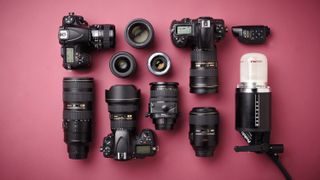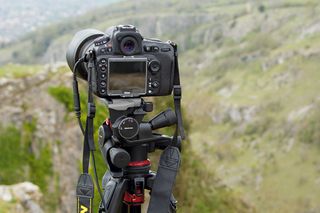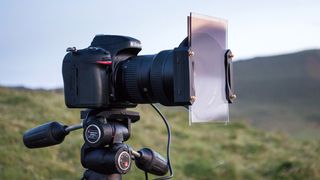
Once you've got your new camera, you may start to wonder what accessories will help you get the most out of your photography or help you take better shots.
Camera shops and online retailers are full of enticing accessories that promise to help with your new hobby, but which do you actually need? Our guide will help you decide what kit to buy.
Essential new camera accessory 1: Camera bag
Why you can trust TechRadar

If you've got a small camera body and a single lens like an entry-level DSLR or mirrorless camera, a bag may not seem essential, but it's a good way to protect them in transport and it keeps rain and dust at bay. And as you build up a collection of lenses and accessories you'll find that you need something to keep it all together and make it easier to carry.
Photo backpacks are a great way to carry heavy kit over long distances or uneven terrain, but because you usually have to take them off your back to access your gear, they can slow you down a bit.
Shoulder camera bags give speedy access, but as the weight is carried on one shoulder it can be uncomfortable with heavy loads over long distances.
There are also quite a few 'sling' bags available now which combine the some of the comfort of a backpack with some of the convenience of a shoulder bag.
Deciding which type of camera bag to go for is a matter of personal preference and how much kit you intend to lug around, but think about how you use your gear when considering the options.
Essential new camera accessory 2: Tripod

A tripod should be an essential part of your camera arsenal because it provides a method of holding your camera at exactly the right angle and keeping it absolutely still, so your images are pin-sharp and full with detail.
Don't be tempted to buy a cheap, flimsy tripod though. You want something sturdy that will keep your camera still in a breeze and not wobble like a jelly every time you touch it or the camera.
ook for a tripod that extends to near eye-level, yet allows you to shoot close to the ground as well. Clip locks on the legs are good for quick deployment, but twist locks take up less room so are slightly better when you're transporting the tripod.
As a rule aluminium tripods are cheaper than carbon fibre, but they are also heavier to carry.
- The 10 best tripods you can buy right now
- The 5 best travel tripods: great carbon fiber stands for your camera
- Why every photographer needs three tripods
Essential new camera accessory 3: Tripod head

A tripod head is the bit that goes between the tripod legs and your camera. Many tripods are sold as a kit with a head, but you can also buy them separately, which give you the opportunity to select the head that suits the way you shoot.
Ball heads can be used for any type of photography and are quick to use, but they are especially well suited to still life and macro photography when the camera needs to be held at strange angles.
However, they can be a pain to use for landscapes when you want to tip the camera up or down but keep the horizon level in the frame. This is when three-way tripod heads are useful as the camera can be moved around three planes individually.
Essential new camera accessory 4: Remote release

A remote release allows you to trip the shutter without touching the camera, so it's useful for longer exposures when the camera is on a tripod as it avoids introducing unwanted camera shake.
Many models also act as bulb timers to enable you to take exposures longer than 30 seconds, and intervalometers that enable you to take a series of images at specific timer intervals for a specified duration.
There are two types of remote release, those that connect to the camera via a cable and wireless releases. Wireless releases have the advantage of working from a longer range and as you're not physically linked to the camera, you can't introduce any wobble.
Essential new camera accessory 5: Additional lenses

The chances are that your camera came with a standard zoom lens which covers a focal length range of around 18-55mm on an APS-C format camera, 14-42mm on Micro Four Thirds or perhaps a 24-105mm on a full-frame model.
This is a great starting point, but it won't be long before you find you need something a bit wider for shooting landscapes or interiors, or you need a telephoto lens to allow you to frame action subjects tightly.
You may also want to get closer to small subjects with a macro lens, or get a dedicated portrait lens with a wide aperture to limit depth of field and blur backgrounds.
- Best lenses for portraits: 5 sensibly priced options tested
- Best wide-angle lenses for Canon and Nikon DSLRs
- Best telephoto zoom lenses for Canon and Nikon DSLRs
- Best macro lenses for Canon and Nikon DSLRs
Essential new camera accessory 6: Filters

Neutral density filters are incredibly popular because they enable you to take long exposure shots in daylight to blur cloud or water movement in landscapes. They also come in handy when you want to shoot with a very wide aperture in bright light.
Meanwhile, graduated neutral density filters enable you to balance the exposure of a bright sky with a darker foreground, and polarising filters are useful to cut down on reflections and boost saturation and contrast.
Filters come in two varieties; round and square (or rectangular). Round filters screw into the filter thread on the front of a lens and need to be bought in a specific size, whereas square filters slide into a holder that mounts on the end of a lens.
Round filters are quick and easy to use, but you need to buy them in the correct size for every lens you use. Alternatively, buy them in the largest filter thread you need and use stepping rings to fit them to your smaller lenses.
Square filters can be transferred between lenses by using different sized adaptor rings. They're the only real choice when using graduated filters as the graduation needs to be located in exactly the right spot over the scene in the viewfinder.
- 5 essential photography filters (and why you can't live without them)
- Best circular polarizer filter: 5 top models tested and rated
- Best neutral density filter: 6 top models tested and rated
Essential new camera accessory 7: Lens and sensor cleaners

Naturally it's important to keep your gear clean. A blower is useful for blowing specks and grit off your camera body and lens before giving it a wipe with a soft lens cloth.
It's also advisable to invest in a sensor cleaning kit because, even though compact system cameras and DSLRs have in-built cleaning mechanisms, sticky pollen and the like can still find its way onto a sensor and it can take some shifting.
You don't need to buy anything fancy, just a pack of sensor cleaning swabs and a small bottle of sensor cleaning fluid will do it, but buy decent stock that won't shed fibres.
Essential new camera accessory 8: Reflector

A reflector is a quick and affordable way to brighten up your portraits and still life images, giving your shots a high-end professional look.
They're incredibly versatile - use them indoors (near windows) or outdoors to bounce light back onto your subject and to fill-in unwanted shadows.
Many reflectors come double-sided or with detachable covers, so you get a choice of white, silver and gold reflective surfaces, allowing you to get slightly different results depending on what you're looking to achieve. The white surfaces of reflectors can also double up as diffusers to soften strong direct sunshine.
If you're really strapped for cash, you can make a reflector by simply using a large sheet of white cardboard - which you can also cover with tin foil for a silver effect - and it should still work a treat!
- How to take stunning natural light portraits
- 14 portrait photography tips you'll never want to forget
Essential new camera accessory 9: Flashgun

The pop-up flash of your camera (if it has one) is useful for adding a little fill-in light, but you'll get greater power and more flattering results from a flashgun.
This can mount in the camera's hotshoe, or for even better results, be fired remotely via a cable or a wireless connection.
For simplicity, get a flashgun that is compatible with your camera's metering system so exposure control is automatic. But if you want to save a bit of money and really get to grips with flash opt for a fully-manual flashgun instead.
- Best flashguns for Nikon DSLRs
- Add drama to your portraits using off-camera flash
- Teach yourself flash: color temperature gels
Essential new camera accessory 10: Flash diffuser

While a flashgun is extremely useful for providing extra illumination, filling in shadows and bringing portraits to life, the light from them can be rather harsh.
A humble piece of translucent plastic can make all the difference, softening the light and making it much more flattering.
There are lots and lots of flash diffusers available on the market, with models that are designed to push-fit onto a flashgun, devices that pop-up to create mini softboxes and even strange bulb-shaped affairs. They are easy to use and on the whole very effective.
Get daily insight, inspiration and deals in your inbox
Get the hottest deals available in your inbox plus news, reviews, opinion, analysis and more from the TechRadar team.
Phil Hall is an experienced writer and editor having worked on some of the largest photography magazines in the UK, and now edit the photography channel of TechRadar, the UK's biggest tech website and one of the largest in the world. He has also worked on numerous commercial projects, including working with manufacturers like Nikon and Fujifilm on bespoke printed and online camera guides, as well as writing technique blogs and copy for the John Lewis Technology guide.

